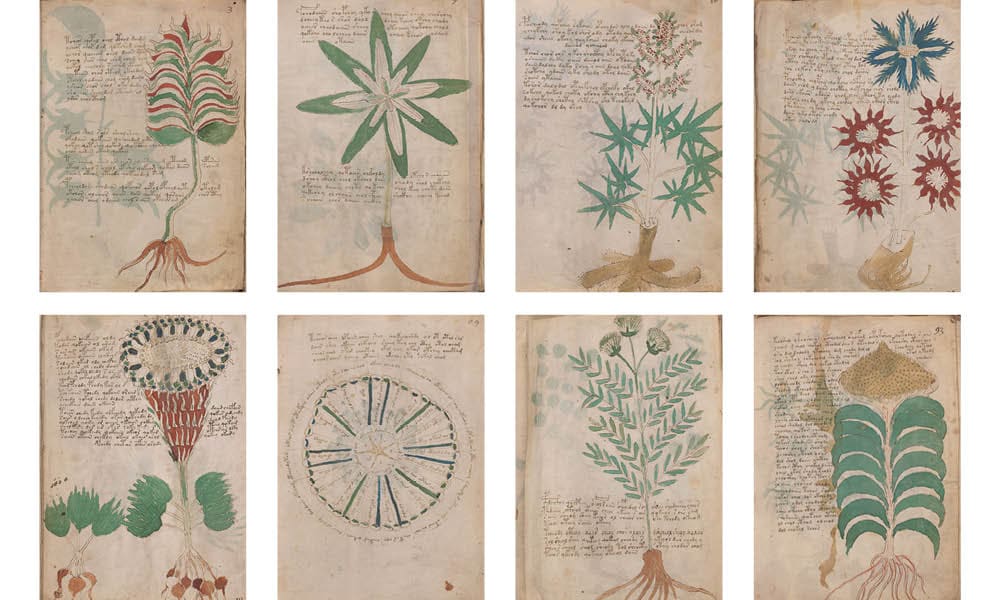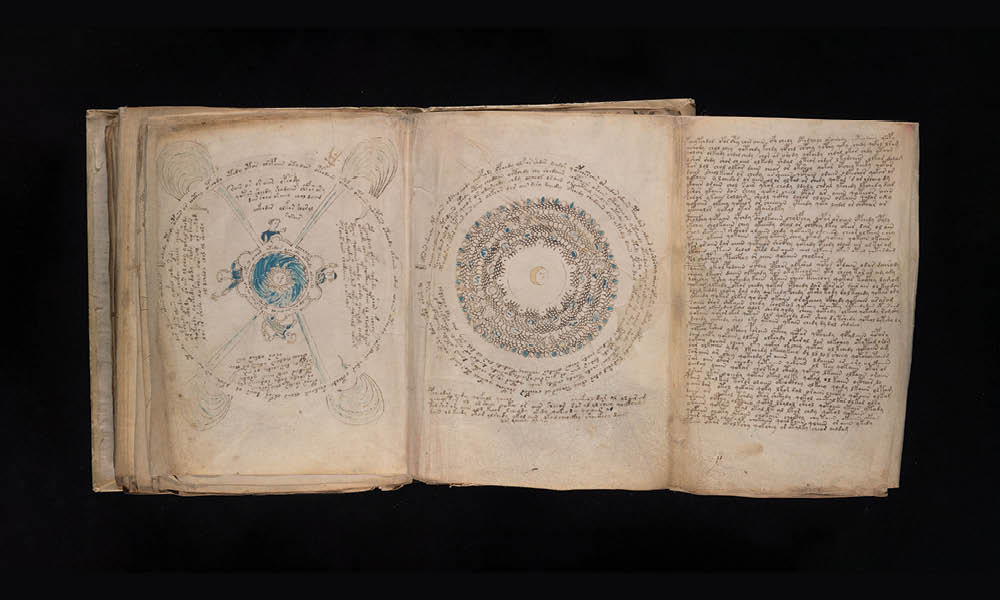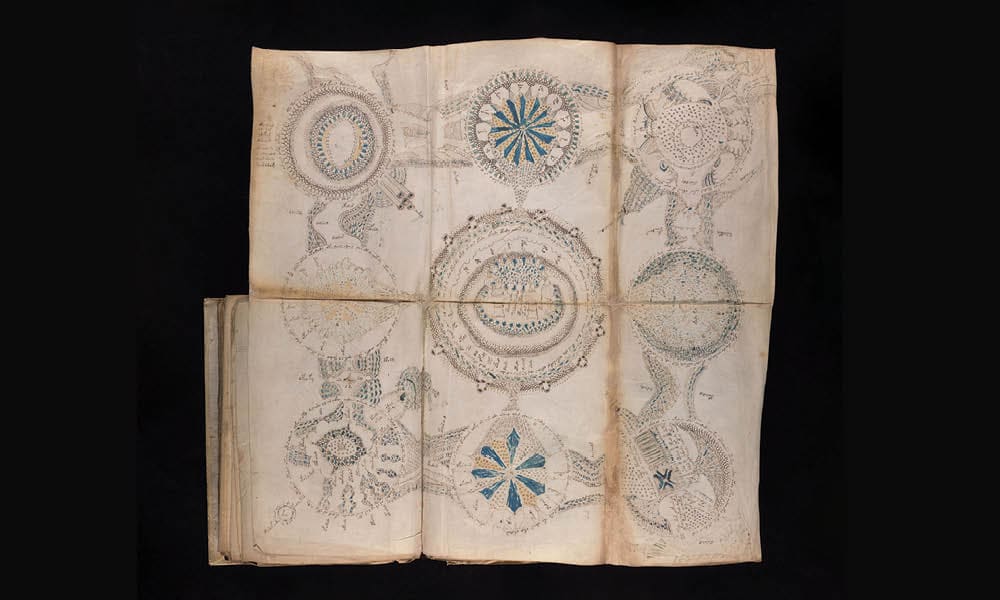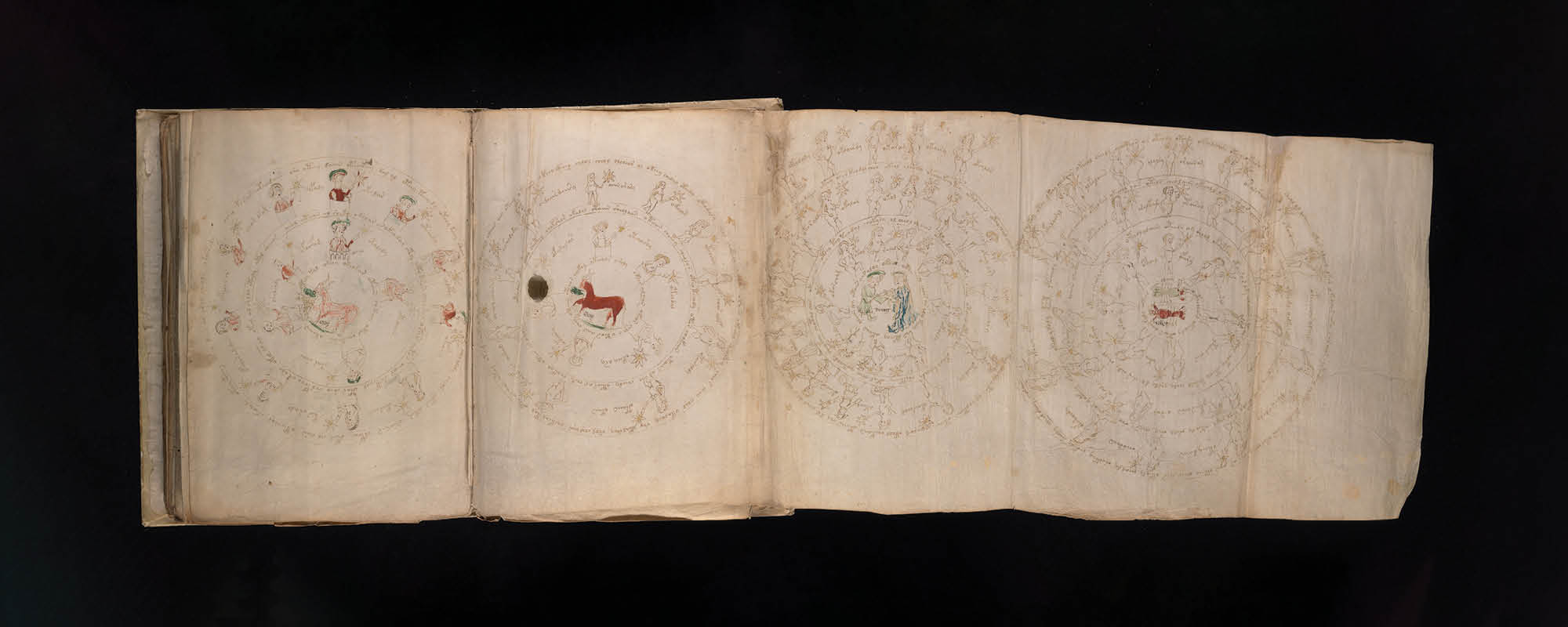The Voynich Manuscript is one of the most enduring historical enigmas, attracting multidisciplinary interest from around the world. Jonathan Firbank speaks with UM’s wing of the Voynich Research Group about the history, mystery, and cutting-edge technology brought together by this unique medieval text.
For 600 years a unique tome has passed from person to person. Its pages, calf skins radio-carbon dated to the 15th century, have outlived at least one binding. Upon them, crude pigments form hallucinatory pictures: astrological geometry, alien vegetation, medieval castles, and tentacular tubes enveloping naked figures. These images snake around a script that’s yet more mysterious: A language with its own alphabet, so indecipherable as to be considered encrypted by some scholars.
This manuscript has enthralled some of the greatest minds of their eras, as they sought to unlock its meaning. It has preserved its secrets even from the latest methods of artificial intelligence, after confounding emperors and their courtiers, codebreakers and spies, and scientists for centuries. Or perhaps it was an elaborate forgery made a mere century ago, created by a socialist revolutionary ironically seeking fortune. Regardless, the sheer difficulty of discovering what the Voynich Manuscript is, and what its content could mean, is creating ever more innovation and collaboration.
A Polymath Riddle
When Wilfrid Voynich discovered the Voynich Manuscript, he sparked a growing intrigue that ensnared many of the 20th century’s greatest cryptographers. Today, the manuscript is a focal point for a multidisciplinary, multinational study falling under the realm of Digital Humanities. Nothing best exemplifies that than the research group behind UM’s recent Voynich Conference. The group combines medievalists, linguists, and AI specialists from both sides of the Atlantic. Dr Colin Layfield introduces them: ‘Prof. John Abela and I’, both from UM’s Department of Computer Information Systems ‘are the “computer bods.” Mike Rosner,’ Affiliate Senior Lecturer of UM’s Department of Artificial Intelligence, ‘is more on the computational linguistics side of things. We have two proper linguistics professors in Prof. Claire Bowern and Prof. Lonneke van der Plas,’ of Yale and the IDIAP Research Institute of Switzerland respectively, ‘Dr Lisa Davis, a paleographer with very good knowledge of the Voynich’, from the Medieval Academy of America, and ‘Dr René Zandbergen who is, in my opinion, the world’s foremost Voynich Manuscript expert.’ The Voynich Manuscript has a long history of keeping polymath thinkers in its orbit, so it is fitting that Zandbergen was a satellite navigation engineer for the European Space Agency.

Rosner elaborates: ‘The manuscript has created a collaboration between disciplines which wouldn’t necessarily get together otherwise. The angle at UM is on a borderline between language, computer science, and AI. But the people we’ve been collaborating with are people who know about ancient language and manuscripts, a study known as palaeography.’ Here, these seemingly disparate fields complement each other. ‘We’ve found that, for them, we’re presenting a refreshing angle. They may have dealt with the Manuscript from a historical perspective, making comparisons with other documents of the time. Whereas we bring a technological angle based on the latest AI and computer science developments.’
But more traditional methods are still vital, as Rosner explains: ’The big problem with the Voynich is that it’s rather small. Enormous amounts of data are used to build models for AI. If you compare it to, say, Wikipedia,’ a key dataset for training such models, the manuscript ‘[…] is a drop in the ocean. That makes it difficult to apply techniques which have been applied successfully to some other languages for which sufficient data is available.’ As Layfield states: ‘Techniques used on the Voynich are often old-school for exactly the reasons Mike has outlined. Many wonderful, modern techniques just aren’t applicable.’
This means that technological and traditional research techniques may depend on each other to uncover the Manuscript’s secrets. One example of the former is a computer-readable version, developed by Zandbergen and Prof. Gabriel Landini. Conversely, a recent breakthrough involved traditional techniques: Davis found the Manuscript appears to have been written in 5 distinct handwriting styles, by separate scribes. Abela describes how these two approaches could interact: ‘As Dr Davis has stated, many medieval documents didn’t survive. However, people all over the world are digitising manuscripts. There might one day be a large enough corpus of medieval manuscripts for us to employ really cool AI techniques for identifying books written by the same people.’

The computer-readable manuscript would facilitate automated cross-referencing for the Manuscript’s language. But the language may turn out to be a unique cypher, either by intention or because other examples have been lost. If the Manuscript is treated as an image, then work by its scribes in a more common language might be discovered. Abela continues: ‘Deep-learning algorithms could learn the nuances in the scripts, then find documents written by the same people. I’m interested in applying Vision Transformers’ (an image interpreting deep learning technique) ‘to the Voynich, to try to learn more about it and its scribes. I’ve already worked with Colin and our students on that, using new transliteration techniques.’ Future discoveries may rely on the interdisciplinary interactions exemplified by the Research Group. Cutting-edge AI utilised by Van der Plas and this article’s interviewees will depend on initial interventions outside the AI space, by researchers like Bowern, Davis, and Zandbergen, who also incorporate AI in their work.
What is the Voynich Manuscript?
There are three pre-eminent theories about the Voynich Manuscript. One is that it is written in a natural language lost to time. The second is that it is authentic but encrypted, written in a cypher that has yet to be decoded. The third is that the Manuscript is a hoax, an indecipherable text created to pique a wealthy collector’s interest – a scam perpetrated by Voynich in 1912, or by another entrepreneurial forger centuries before. All options are on the table as there is no concrete evidence that completely supports one theory. The questions don’t end there, the Manuscript’s authorship has enjoyed a century of speculation. As Layfield states: ‘Voynich himself claimed it was written by Roger Bacon,’ the 13th-century scientist and theologian. ‘Others postulate it was written by John Dee (advisor and spymaster to Elizabeth I), who then sold it to Rudolf II,’ the Hapsburg Emperor in around 1600. ‘Some people think DaVinci wrote it. Others think it was aliens,’ presumably because they had a lot of free time between building the pyramids and pestering 20th-century farmers. ‘Every year, I get emails from people claiming to have deciphered it,’ but a definitive answer has not stood up to scrutiny thus far.
One irrefutable thing, however, is that the Voynich Manuscript has long been associated with scientific development. At UM’s Voynich Conference, Dr Keagen Brewer explored a compelling theory that the manuscript relates to women’s health. The botanical images may depict plant-based medicine, and the images of naked women amidst organic tubes and chambers may symbolise gynaecology. This would explain the encryption, as the subject was often censored. Its scientific associations only grow from there: Bacon, Dee, and Rudolf II were all instrumental in the development of empiricism and the natural sciences, as was its (likely) subsequent owner, Kircher. Layfield continues: ‘When the Voynich was rediscovered, centuries later, it contained a letter to Athanasius Kircher (dated 19 August 1665). He was the rockstar scientist of his day, working in optics, language, mathematics, physics, and natural law.’ He was the obvious person of the day to send this to for further investigation.

Upon Voynich’s death, the manuscript was inherited by his widow, celebrated author Ethel Voynich (best known for her novel The Gadfly). ‘This is interesting for computer scientists since her father, George Boole, invented Boolean algebra,’ computer programming’s foundational mathematics.
Behind the glaring question of “What is the Voynich Manuscript?” there hides another question: “What is the Voynich Manuscript doing for us?” As technological achievements have accelerated, the Manuscript has kept pace. It compels innovation, it demands collaboration and, should our best efforts fail, it defines our intellectual limitations – limitations which, when we break them, may be reassessed by trying to decode it once more. The Voynich Manuscript is both a partner to and a matchmaker for academics across temporal and geographical boundaries. In that sense, the existence of this riddle may be more important than the answer to this riddle. Unless, of course, it was written by aliens.





Comments are closed for this article!